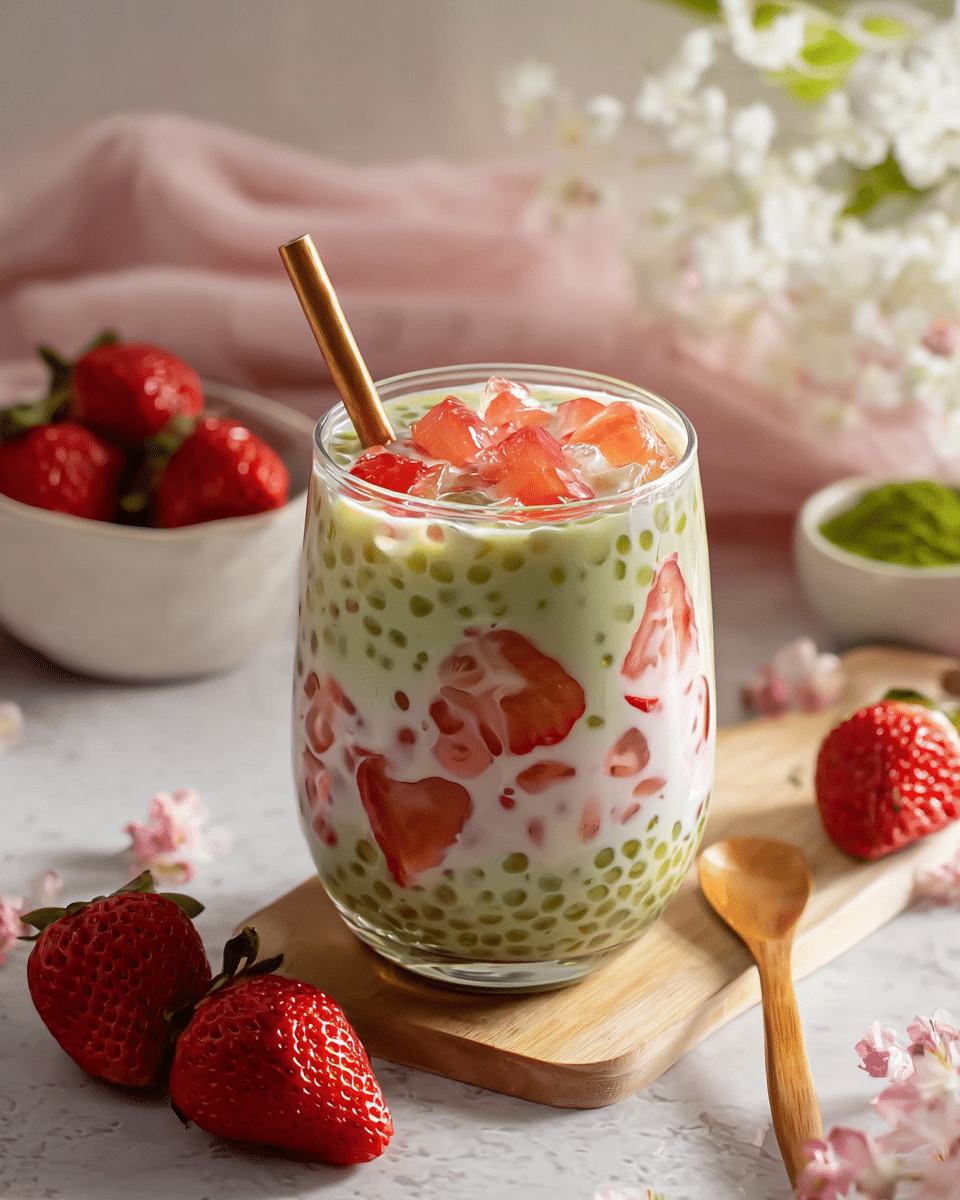The Strawberry Matcha Sago is a beautifully balanced dessert that blends the earthy flavor of ceremonial matcha with the natural sweetness of ripe strawberries. Combined with chewy sago pearls and fruity coconut and strawberry jellies, this chilled dessert is a delightful way to cool down while indulging in layers of texture and flavor.
This recipe is as visually striking as it is delicious. With a lush green matcha base, vibrant red strawberries, and translucent pearls and jellies, it’s perfect for parties, potlucks, or a special after-dinner treat. Easily customizable and quick to prepare, it’s a modern take on traditional Asian tong sui that’s sure to impress.
Full Recipe:
Ingredients:
-
½ cup sago (small dried pearls)
-
2 tablespoons (12 g) ceremonial grade matcha powder
-
½ cup (120 ml) hot water (176°F / 80°C)
-
1 cup regular milk (or plant-based milk of choice)
-
¾ cup evaporated milk
-
¼ cup condensed milk (adjust to taste)
-
1 cup fresh strawberries, diced
-
1 cup coconut jelly
-
½ cup strawberry heart jelly (optional)
-
Ice (for serving)
Directions:
-
Bring a medium saucepan of water to a boil. Add the sago, reduce to medium-high heat, and simmer for 15 minutes, stirring occasionally.
-
Remove from heat, cover the pot, and let the sago sit for another 10–15 minutes until fully translucent.
-
Strain and rinse the sago with cold water to stop cooking. Soak the strainer with sago in a bowl of cold water to prevent drying.
-
In a separate bowl, sift the matcha powder and whisk with hot water in a “W” motion until frothy. Add the milk and stir to combine.
-
Drain the sago and transfer to a large bowl. Add evaporated milk, condensed milk, matcha milk, diced strawberries, coconut jelly, and optional strawberry jelly.
-
Add ice and serve immediately in chilled dessert cups.
Prep Time: 5 minutes | Cooking Time: 25 minutes | Total Time: 30 minutes
Kcal: 181 kcal | Servings: 6 servings
Strawberry Matcha Sago: A Modern Asian Dessert with Depth, Color, and Comfort
In the ever-evolving world of global desserts, few modern fusions have captured the hearts of home cooks and foodies quite like Strawberry Matcha Sago. Refreshing, vibrant, and brimming with texture, this dish seamlessly blends traditional Asian culinary elements with trendy contemporary flavors. Whether you’ve encountered it on social media or at your local Asian café, one spoonful of this dessert can transport you into a world of creamy matcha, juicy strawberries, and chewy pearls.
But what exactly is Strawberry Matcha Sago? Why is it so popular? And how can you bring this chilled treat into your home kitchen, not just as a dessert, but as a conversation starter?
Let’s dive into the story behind this refreshing bowl of delight.
The Evolution of Sago-Based Desserts
To understand the magic of Strawberry Matcha Sago, it’s helpful to first explore its roots. The dessert draws inspiration from traditional tong sui (literally “sugar water”) a family of sweet, soupy Chinese desserts often served warm or chilled. One of the most well-known members of this category is Mango Sago, which has been a beloved staple in Hong Kong-style dessert shops since the 1980s.
Sago itself is a starch extracted from tropical palm stems and forms small pearls when processed, similar in appearance to tapioca. In desserts, these pearls cook up translucent and chewy, offering a unique, bouncy texture that many people find addictive.
As Asian fusion cuisine gained momentum across the globe, chefs and food bloggers began to riff on classic tong sui recipes. Enter Strawberry Matcha Sago a creative twist that replaces the mango and coconut base with fresh strawberries and an aromatic matcha-infused milk blend.
Flavor and Texture: A Harmonious Balance
One of the reasons this dessert has gone viral is its unforgettable flavor and texture profile. The ingredients may be relatively simple, but their combination is thoughtfully layered to deliver a sophisticated sensory experience.
-
Matcha Milk Base – Earthy and slightly bitter, matcha (powdered green tea) balances out the sweetness of the dessert. Mixed with a combination of milk and sweetened condensed milk, it becomes creamy, rich, and frothy.
-
Fresh Strawberries – Sweet, tangy, and slightly acidic, strawberries add both flavor and visual vibrance. Their juicy freshness cuts through the creaminess of the matcha base, creating a refreshing balance.
-
Sago Pearls – These chewy, jelly-like pearls are the textural heart of the dish. They don’t offer much flavor on their own but absorb the surrounding liquids beautifully, providing a subtly sweet, gummy mouthfeel with every bite.
-
Coconut and Fruit Jellies – Optional, but highly recommended, fruit-flavored jellies especially coconut or strawberry add extra pops of color and fun textures that keep each spoonful interesting.
The layering of textures soft fruits, chewy pearls, and silky matcha milk makes it one of the most delightful mouthfeels you can experience in a dessert.
Visual Appeal: A Social Media Star
There’s no denying that Strawberry Matcha Sago is an Instagram-worthy dessert. The aesthetic appeal lies in its naturally vibrant colors: the deep green of the matcha, the ruby red strawberries, the opalescent pearls, and the jelly’s glassy hues.
Served in transparent glass cups or bowls, the dessert looks like a minimalist parfait inviting, clean, and elegant. Add a few ice cubes or chill the mixture before serving, and it becomes the ultimate summer dessert that not only tastes good but also cools you down.
It’s no wonder this dish has been making the rounds on platforms like TikTok, Instagram, and Pinterest. Home cooks love the combination of simplicity and visual payoff, while food bloggers enjoy putting their own spin on it with custom toppings or dairy-free adaptations.
Nutritional Considerations
Although desserts are meant to be indulgent, Strawberry Matcha Sago can actually be quite a balanced choice when compared to many Western counterparts like cakes or cookies. Depending on the choice of milk and sweetener, it can be tailored to a variety of dietary preferences.
Here are a few nutritional angles to consider:
-
Matcha is rich in antioxidants, particularly catechins, which are believed to reduce inflammation and promote heart health.
-
Strawberries provide vitamin C, fiber, and antioxidants while being relatively low in calories.
-
Milk Options can range from whole dairy to lighter plant-based versions like almond, oat, or macadamia milk.
-
Sweeteners can be adjusted while traditional recipes call for condensed milk, you can swap in honey, maple syrup, or agave for a more natural sweetness.
For those watching their sugar intake or seeking a vegan version, this dessert is highly customizable and can be made as light or rich as desired.
Customization & Variations
What makes this dessert such a modern favorite is how versatile it is. Here are a few popular adaptations:
-
Dairy-Free/Vegan Version – Use oat or almond milk and sweeten with agave or coconut sugar.
-
Tropical Twist – Add canned lychee, jackfruit, or longan for a Southeast Asian flavor profile.
-
Extra Texture – Popping boba or flavored jellies can add new layers of fun.
-
More Matcha – Love that grassy matcha flavor? Make a concentrated matcha shot and drizzle it over the top as a final flourish.
-
Less Sweet – Omit or reduce the condensed milk and rely on the natural sweetness of strawberries or add just a touch of syrup.
You can also create a deconstructed version for elegant plating in fine dining contexts, or serve it buffet-style in large batches for parties and gatherings.
Why It’s Perfect for Entertaining
Strawberry Matcha Sago is an entertainer’s dream for several reasons:
-
Make-Ahead Friendly – The sago pearls can be cooked and stored in water a day ahead. The matcha milk and strawberries can also be prepped early and assembled right before serving.
-
Served Chilled – Perfect for summer events or backyard dinners.
-
Appeals to All Ages – Both kids and adults enjoy its combination of fun textures and fruity sweetness.
-
Flexible Portions – Serve it in shot glasses for tasting menus or in larger bowls as a refreshing dessert.
Cultural Significance: A Global Adaptation
This dessert may be born of fusion, but it still holds a strong connection to its roots in East Asian culinary tradition. It’s a prime example of how younger generations are reimagining heritage recipes to suit modern tastes without losing their identity.
The use of matcha not only adds a popular flavor but also pays homage to Japanese tea culture. Meanwhile, sago pearls and jelly reflect influences from Hong Kong-style cafes and Southeast Asian dessert houses.
In essence, Strawberry Matcha Sago is a love letter to multiculturalism in food an edible metaphor for blending tradition with innovation.
Conclusion:
Whether you’re a matcha fanatic, a fruit dessert lover, or simply someone who enjoys a refreshing treat that’s as beautiful as it is tasty, Strawberry Matcha Sago deserves a spot in your dessert repertoire.
It’s easy to prepare, endlessly customizable, and doesn’t require special equipment. It’s also a dessert that encourages creativity play with the proportions, adjust the sweetness, add your favorite fruits or textures, and make it your own.
Best of all, it’s one of those rare recipes where elegance and effortlessness meet. A perfect dish to impress guests, enjoy with family, or savor in solitude with a spoon and a smile.






